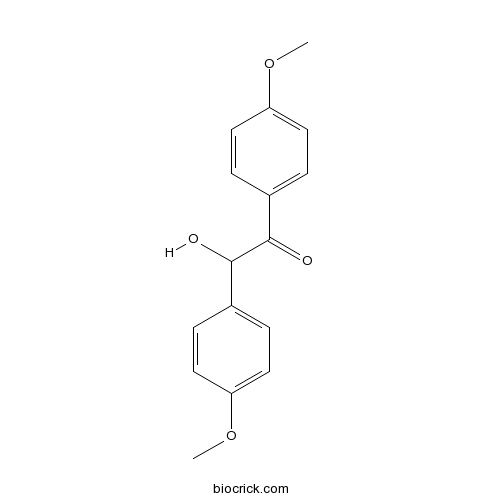p-AnisoinCAS# 119-52-8 |

Quality Control & MSDS
3D structure
Package In Stock
Number of papers citing our products

| Cas No. | 119-52-8 | SDF | Download SDF |
| PubChem ID | 95415 | Appearance | Powder |
| Formula | C16H16O4 | M.Wt | 272.3 |
| Type of Compound | N/A | Storage | Desiccate at -20°C |
| Solubility | Soluble in Chloroform,Dichloromethane,Ethyl Acetate,DMSO,Acetone,etc. | ||
| Chemical Name | 2-hydroxy-1,2-bis(4-methoxyphenyl)ethanone | ||
| SMILES | COC1=CC=C(C=C1)C(C(=O)C2=CC=C(C=C2)OC)O | ||
| Standard InChIKey | LRRQSCPPOIUNGX-UHFFFAOYSA-N | ||
| Standard InChI | InChI=1S/C16H16O4/c1-19-13-7-3-11(4-8-13)15(17)16(18)12-5-9-14(20-2)10-6-12/h3-10,15,17H,1-2H3 | ||
| General tips | For obtaining a higher solubility , please warm the tube at 37 ℃ and shake it in the ultrasonic bath for a while.Stock solution can be stored below -20℃ for several months. We recommend that you prepare and use the solution on the same day. However, if the test schedule requires, the stock solutions can be prepared in advance, and the stock solution must be sealed and stored below -20℃. In general, the stock solution can be kept for several months. Before use, we recommend that you leave the vial at room temperature for at least an hour before opening it. |
||
| About Packaging | 1. The packaging of the product may be reversed during transportation, cause the high purity compounds to adhere to the neck or cap of the vial.Take the vail out of its packaging and shake gently until the compounds fall to the bottom of the vial. 2. For liquid products, please centrifuge at 500xg to gather the liquid to the bottom of the vial. 3. Try to avoid loss or contamination during the experiment. |
||
| Shipping Condition | Packaging according to customer requirements(5mg, 10mg, 20mg and more). Ship via FedEx, DHL, UPS, EMS or other couriers with RT, or blue ice upon request. | ||

p-Anisoin Dilution Calculator

p-Anisoin Molarity Calculator
| 1 mg | 5 mg | 10 mg | 20 mg | 25 mg | |
| 1 mM | 3.6724 mL | 18.3621 mL | 36.7242 mL | 73.4484 mL | 91.8105 mL |
| 5 mM | 0.7345 mL | 3.6724 mL | 7.3448 mL | 14.6897 mL | 18.3621 mL |
| 10 mM | 0.3672 mL | 1.8362 mL | 3.6724 mL | 7.3448 mL | 9.1811 mL |
| 50 mM | 0.0734 mL | 0.3672 mL | 0.7345 mL | 1.469 mL | 1.8362 mL |
| 100 mM | 0.0367 mL | 0.1836 mL | 0.3672 mL | 0.7345 mL | 0.9181 mL |
| * Note: If you are in the process of experiment, it's necessary to make the dilution ratios of the samples. The dilution data above is only for reference. Normally, it's can get a better solubility within lower of Concentrations. | |||||

Calcutta University

University of Minnesota

University of Maryland School of Medicine

University of Illinois at Chicago

The Ohio State University

University of Zurich

Harvard University

Colorado State University

Auburn University

Yale University

Worcester Polytechnic Institute

Washington State University

Stanford University

University of Leipzig

Universidade da Beira Interior

The Institute of Cancer Research

Heidelberg University

University of Amsterdam

University of Auckland

TsingHua University

The University of Michigan

Miami University

DRURY University

Jilin University

Fudan University

Wuhan University

Sun Yat-sen University

Universite de Paris

Deemed University

Auckland University

The University of Tokyo

Korea University
- 7-Anilino-4-hydroxy-2-naphthalenesulfonic acid
Catalog No.:BCC8777
CAS No.:119-40-4
- Methyl salicylate
Catalog No.:BCN5372
CAS No.:119-36-8
- 8-Amino-2-naphthalenesulfonic acid
Catalog No.:BCC8783
CAS No.:119-28-8
- Viscumneoside III
Catalog No.:BCN7698
CAS No.:118985-27-6
- 1-O-Deacetyl-2alpha-hydroxykhayanolide E
Catalog No.:BCN1604
CAS No.:1189801-51-1
- Fumitremorgin C
Catalog No.:BCC7507
CAS No.:118974-02-0
- Mephedrone hydrochloride
Catalog No.:BCC6183
CAS No.:1189726-22-4
- Ethyl ganoderate J
Catalog No.:BCN3486
CAS No.:1189555-95-0
- (S,S)-2,6-Bis(4-isopropyl-2-oxazolin-2-yl)pyridine
Catalog No.:BCC8402
CAS No.:118949-61-4
- 1,3-Dihydroxy-4-methoxy-10-methylacridin-9(10H)-one
Catalog No.:BCN1605
CAS No.:1189362-86-4
- 5-(3-Hydroxypropyl)-7-methoxybenzofuran
Catalog No.:BCN1606
CAS No.:118930-92-0
- Balanophonin
Catalog No.:BCN6072
CAS No.:118916-57-7
- Benzoin
Catalog No.:BCC8854
CAS No.:119-53-9
- Benzophenone
Catalog No.:BCC8859
CAS No.:119-61-9
- 2-Carboxybenzaldehyde
Catalog No.:BCN2274
CAS No.:119-67-5
- 5-Amino-2-naphthalenesulfonic acid
Catalog No.:BCC8732
CAS No.:119-79-9
- 3,4-Dihydrocoumarin
Catalog No.:BCN6793
CAS No.:119-84-6
- 2,2'-Biquinoline
Catalog No.:BCC8489
CAS No.:119-91-5
- Abiesinol F
Catalog No.:BCN6418
CAS No.:1190070-91-7
- 4-[2-[(3-Ethyl-4-methyl-2-oxo-3-pyrrolin-1-yl)carboxamido]ethyl]benzenesulfonamide
Catalog No.:BCC8672
CAS No.:119018-29-0
- M2 ion channel blocker
Catalog No.:BCC1726
CAS No.:1190215-03-2
- Sarcandrone A
Catalog No.:BCN6073
CAS No.:1190225-47-8
- Sarcandrone B
Catalog No.:BCN6074
CAS No.:1190225-48-9
- PSI-7977
Catalog No.:BCC1871
CAS No.:1190307-88-0
Isolation and characterization of Rhizobium sp. strain YS-1r that degrades lignin in plant biomass.[Pubmed:28092137]
J Appl Microbiol. 2017 Apr;122(4):940-952.
AIMS: The aim of this work was to isolate novel lignin-degrading organisms. METHODS AND RESULTS: Several pure cultures of bacteria that degrade lignin were isolated from bacterial consortia developed from decaying biomass. Among the isolates, Rhizobium sp. strain YS-1r (closest relative of Rhizobium petrolearium strain SL-1) was explored for its lignin-degrading ability. Microcosm studies showed that strain YS-1r was able to degrade a variety of lignin monomers, dimers and also native lignin in switchgrass and alfalfa. The isolate demonstrated lignin peroxidase (LiP) activity when grown on alkali lignin, p-Anisoin, switchgrass or alfalfa, and only negligible activity was measured in glucose-grown cells suggesting inducible nature of the LiP activity. Analysis of the strain YS-1r genome revealed the presence of a variety of genes that code for various lignin-oxidizing, H2 O2 -producing as well as polysaccharide-hydrolysing enzymes. CONCLUSIONS: This study shows both the genomic and physiological capability of bacteria in the genus Rhizobium to metabolize lignin and lignin-like compounds. This is the first detailed report on the lignocellulose-degrading ability of a Rhizobium species and thus this study expands the role of alpha-proteobacteria in the degradation of lignin. SIGNIFICANCE AND IMPACT OF THE STUDY: The organism's ability to degrade lignin is significant since Rhizobia are widespread in soil, water and plant rhizospheres and some fix atmospheric nitrogen and also have the ability to degrade aromatic hydrocarbons.


